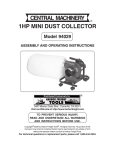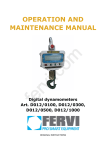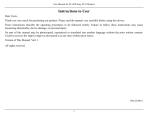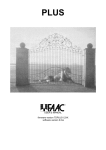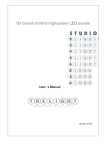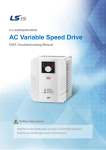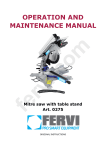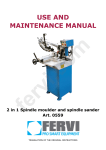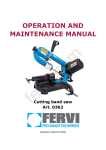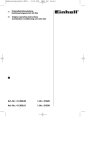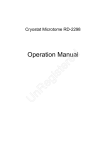Download OPERATION AND MAINTENANCE MANUAL
Transcript
OPERATION AND MAINTENANCE MANUAL c .i v r e f m o Manual stacker with brake and lifting foot pedal Art. 0143 TRANSLATION OF THE ORIGINAL INSTRUCTIONS MACHINES AND ACCESSORIES PREFACE Please ensure you have read this manual before any operation TRANSLATION OF THE ORIGINAL INSTRUCTIONS It is compulsory to read this instruction manual before starting operation. The guarantee that the machine will function and perform properly is strictly dependent upon the application of all the instructions contained in this manual. Operator Qualifications m o c .i The workers in charge of using this machine must possess all the necessary information and instruction and should be given adequate training in relation to safety regarding: a) Conditions of use for the equipment; b) Foreseeable abnormal situations, pursuant to Article 73 of Legislative Decree 81/08. v r e f We guarantee the Machine complies with the specifications and technical instructions described in the Manual on the date of its issuance (shown in this page). On the other hand, the machine may also be subject to important technical changes in the future, without the manual being updated. Therefore, contact FERVI for information about modifications that may have been implemented. REV. 2 Page 2 of 33 November 2013 MACHINES AND ACCESSORIES CONTENTS 1 1.1 2 INTRODUCTION ........................................................................................ 5 Preface..........................................................................................................................6 2. GENERAL SAFETY WARNING ................................................................. 7 m o 2.1 Technical Assistance .....................................................................................................8 2.2 Other provisions ...........................................................................................................8 3 TECHNICAL SPECIFICATIONS AND FUNCTIONS ........................................ 9 4 INTENDED USE AND DESCRIPTION OF THE MACHINE............................. 11 4.1 5 Safety devices ............................................................................................................. 13 c .i USE OF PERSONAL PROTECTIVE EQUIPMENT.......................................... 14 5.1 Identification Plate and Pictograms ............................................................................ 14 5.2 Maximum rated load capacity ..................................................................................... 17 6 MISUSE AND CONTRAINDICATIONS ....................................................... 18 7 TRANSPORTING, LIFTING AND MOVING ................................................. 20 7.1 8 v r Lifting the Truck pallet ................................................................................................ 20 COMMISSIONING.................................................................................... 21 8.1 Unpacking instructions ............................................................................................... 21 8.2 Checking the machine ................................................................................................. 21 9 e f MACHINE OPERATION............................................................................. 22 9.1 Taking the load from a pile or from a shelf ................................................................. 23 9.2 Lifting the load............................................................................................................ 24 9.3 Releasing the load onto a pile or a shelf ..................................................................... 24 9.4 Parking brakes ............................................................................................................ 25 9.4.1 Locking of the brakes ............................................................................................... 25 9.4.2 Unlocking of the brakes ............................................................................................ 25 10 MAINTENANCE ........................................................................................ 26 10.1 Daily inspections or every 8 hours .............................................................................. 26 10.2 Verification tests, daily or every 8 hours..................................................................... 26 10.3 Long-term maintenance and inspection programmes ................................................. 27 10.3.1 Monthly inspections or every 100 hours ...................................................................... 27 10.3.2 6-monthly inspections or every 500 hours................................................................... 27 10.3.3 Annual inspections or every 1,000 hours..................................................................... 27 11 TROUBLESHOOTING................................................................................ 28 12 DECOMMISSIONING ............................................................................... 29 12.1 Machine downtime ...................................................................................................... 29 Page 3 of 33 MACHINES AND ACCESSORIES 12.2 Disassembly and disposal of materials and components ............................................. 29 13 REPLACEMENT PARTS ............................................................................. 30 v r c .i e f Page 4 of 33 m o MACHINES AND ACCESSORIES 1 INTRODUCTION This manual is delivered with the machine, and it must be regarded as an inseparable part of it. The manufacturer holds all ownership to material and intellectual property of this manual; any disclosure or copying, even partial, of this publication without prior written consent is forbidden. The purpose of this manual is to provide the knowledge necessary for the use and maintenance of the machine Sollevatore per pallet Art.0143 and create a sense of responsibility and an understanding of the capabilities and limitations of the means entrusted to the operator. As the machine is entrusted to experienced and skilled operators, the following machine must be perfectly known by the operator if you want it to be used safely and effectively. Operators must be properly trained and prepared, so make sure that this manual is read and consulted by the staff responsible for commissioning, operation and maintenance of the Sollevatore per pallet. This is to make all operations the safest and most effective possible for those who carry out these tasks. Therefore, it is imperative to strictly comply with the requirements in this manual, a necessary condition for safe and satisfactory operation of the machine. Prior to installation and use of the Sollevatore per pallet, authorised personnel shall: carefully read this technical document; know which protections and safety devices are available on the machines, their location and how they work. m o v r c .i It is the responsibility of the buyer to ensure that users are properly trained, that they are aware of all the information and instructions in this document and that they are aware of the potential risks that exist while working with the Sollevatore per pallet. e f The manufacturer waives any and all responsibility for damage to people and/or things caused by non-observance of the instructions in this manual. The Sollevatore per pallet was designed and built with mechanical guards and safety devices designed to protect the operator/user from possible injury. It is strictly forbidden to modify or remove guards, safety devices and caution labels. If you do so temporarily (for example, for the purposes of cleaning or repair), make sure that no one can use the machine. Modifications to the machine carried out by the user must be considered their sole responsibility, therefore the manufacturer waives any and all responsibility for any damage caused to persons and/or property resulting from maintenance performed by unqualified personnel and in a manner unlike the operating procedures shown below. Page 5 of 33 MACHINES AND ACCESSORIES GRAPHIC REPRESENTATION OF SAFETY, OPERATIONAL AND RISK WARNINGS The following boxes are designed to attract the attention of the reader / user for the proper and safe use of the machine: Pay attention This highlights behavioural rules to prevent damage to the machine and/or the occurrence of dangerous situations. m o Residual Risks This highlights the presence of dangers that cause residual risks to which the operator must pay attention in order to avoid injury or damage to property. c .i 1.1 Preface For safe and easy operation of the Sollevatore per pallet, this manual must be read carefully in order to acquire the necessary knowledge. In other words, durability and performance are strictly dependent on how it is used. Even if already familiar with the Sollevatore per pallet, it is necessary to follow the instructions contained herein, in addition to the general precautions to be observed while working. Acquire full knowledge of the machine. Read this manual carefully to understand: operation, safety devices and all necessary precautions. All this is to allow safe use of the equipment. Wear appropriate clothing for the job. The operator must wear appropriate clothing, so as to prevent the occurrence of unpleasant accidents. Maintain the machine with care. v r e f Operating the machine The machine must only be used by qualified personnel trained to use the machine by authorized personnel. Page 6 of 33 MACHINES AND ACCESSORIES 2 2. GENERAL SAFETY WARNING Even if you are already familiar with the Sollevatore per pallet Art.0143, you must read this manual carefully to acquire full knowledge of the machine and the general precautions to be observed during operation Risks related to Using the Machine Do NOT underestimate the risks related to the use of the machine and stay focused on the work you are carrying out. m o Risks related to Using the Machine Despite the implementation of all safety devices for safe use of the machine, it is necessary to take note of all the accident prevention requirements highlighted in various parts of this manual. c .i Risks related to Using the Machine Every person who is responsible for the use and maintenance of the machine should first have read the instruction manual, particularly the chapter dealing with safety. It is recommended that the plant safety manager get written confirmation of the above. v r e f Risks related to Using the Machine During all work phases with the machine, you should proceed with great caution in order to avoid damage to persons, to the property or to the machine itself. Please use the machine only for its expected uses (drilling or tapping). Don't tamper with the safety devices equipping the machine. Risks related to Using the Machine Before starting any work on the machine, the operator must wear the appropriate personal protective equipment (PPE) such as gloves and eye protection. 1. Do not try to operate the machine at higher performance levels than those for which it was designed, in particular regarding the size of the load to be lifted (capacity). 2. It is recommended that users of this publication, for maintenance and repair, have a basic knowledge of mechanical principles and of repair technique procedures. 3. Replace worn or damaged parts, check that the repairs and protection work correctly before operating. Use only original spare parts ! 4. Make sure that the work environment is forbidden to children and non-employees. Page 7 of 33 MACHINES AND ACCESSORIES 5. The company safety manager is responsible for monitoring the company's risk status according to Legislative Decree no. 81/08 and subsequent modifications and amendments. 2.1 Technical Assistance For any problems or concerns, please contact, without hesitation the Customer Service Department of your dealer, who has competent and specialized staff, specific equipment and spare parts. 2.2 Other provisions m o IT IS FORBIDDEN TO TAMPER WITH SAFETY DEVICES The first thing to do when starting work is to check for the presence and integrity of the protections and the operation of the safety devices. If any defect is encountered do not use the machine! c .i Even more so, it is strictly forbidden to modify or remove guards, safety devices, labels and indication signs. v r e f Page 8 of 33 MACHINES AND ACCESSORIES 3 TECHNICAL SPECIFICATIONS AND FUNCTIONS Description (unit of measurement) Ref. Art. 0143 Q 1,000 Minimum fork height (mm) h 90 Maximum fork height (mm) H 1,600 Fork length (mm) L Fork width (mm) E Centre of gravity distance (mm) C Maximum length (mm) A Maximum capacity (kg) Up to 1,600 mm Total height (mm) Rollers diameter (mm ) Steering wheels diameter (mm) v r Ground light (mm) Outer turning radius (mm) Empty weight (kg) Lifting speed (mm/sec) e f X m o R < 1,590 / 200 c .i Maximum width (mm) B F / / 1,150 550 600 1,670 690 2,000 80 150 > 30 > 16 Page 9 of 33 MACHINES AND ACCESSORIES c .i v r e f m o Figure 1 - Overall dimensions of the machine Page 10 of 33 MACHINES AND ACCESSORIES 4 INTENDED USE AND DESCRIPTION OF THE MACHINE The Manual stacker with brake and lifting foot pedal (Art. 0143) is a machine designed for the lifting and movement of loads, arranged on pallets or in normalized containers, on flat smooth floors (such as the floors of industrial warehouses) with appropriate hardness and resistance (capable of supporting the weight of the Truck Pallet plus the maximum rated load capacity). The working environment must also be sufficiently lit to ensure maximum operational safety (at least 50 lux are recommended). The operating temperature is within the range – 5 / + 45°C. Other types of use, or the extension of use beyond that envisaged, does not correspond to the designation attributed by the manufacturer, and therefore the latter cannot accept any responsibility for any damage resulting therefrom. c .i 9 6 v r 5 3 2 1 7 8 9 e f Figure 2 - Overview m o Figure 3 – Close-up of brakes and wheel guards. 4 10 Figure 4 – Close-up of bracket. 11 Figure 5 - Travel stop device. Page 11 of 33 MACHINES AND ACCESSORIES 1 Lifting control lever 7 Drawbar pedal 2 Drawbar 8 Steering or guiding wheels 3 Forks 9 Parking brake 4 Rollers 10 Chain holding bracket 5 Lifting cylinder 11 Mechanical travel stop devices 6 Lifting chain m o The pedal parking brakes (ref. 9), consisting of two moveable brackets are installed on the swivel wheels and protect the truck against the dangers arising from unwanted movement while parked and/or during the lifting/lowering of the load. For a more detailed explanation on the operation of the parking brakes see paragraph 9.4. c .i The chain holding bracket (ref. 10 in Figure 4), prevents the lifting chain from whiplashing dangerously in the event it suddenly breaks. The mechanical travel stop devices (ref. 11 in) on the upper part of the mast, limit the upstroke of the fork carriage preventing it from detaching and falling. v r The load limiter, constituted by a maximum pressure valve (see Figure 6), ensures the trolley is not overloaded. This valve, ensures that the pressure inside the hydraulic circuit can not exceed the fixed set value determined by the maximum rated load capacity. e f Figure 6 – View of the limiter. Page 12 of 33 MACHINES AND ACCESSORIES The Truck Pallet consists of: a strong metal structure, consisting of a pair of forks (ref. 3) that can be varied in height from ground level; a lifting chain (ref. 6) connected to the fork carriage; a lifting cylinder (ref. 5) driven by hydraulic oil under pressure; two polyurethane rollers (ref. 4), which support the machine and allow translation; a hydraulic unit, controlled by a drawbar (ref. 2) that allows the forks to be raised and lowered; a pair of swivel wheels (ref. 8) that allow the direction of travel to be set; two pedal parking brakes (ref. 9) which, when activated, prevent the movement of the pallet. m o 4.1 Safety devices The main safety devices present on the machine are: The pedal parking brakes; The crush resistant guards on the steering wheels (drawbar side); The anti-shearing mesh on the mast; The chain holding bracket of the lifting chain; The mechanical travel stop device on the upper part of the mast; The load limiter; The identification plate indicating the maximum load capacity. v r c .i The crush resistant guards on the steering wheels (ref. 8 in Figure 3) prevent the operator's feet from being crushed and/or knocked by the wheels when moving the truck. In any event, the operator is required to wear safety shoes. The anti-shearing mesh on the mast prevents the hands and fingers of the operator assigned to operate the truck from being crushed between the moving parts of the mast when using the truck. e f Page 13 of 33 MACHINES AND ACCESSORIES 5 USE OF PERSONAL PROTECTIVE EQUIPMENT. Use of PPE ALWAYS use appropriate personal protective equipment (PPE), such as: Crush resistant safety gloves; Overalls or aprons; Safety shoes. c .i m o Figure 7 – Personal Protective Equipment. 5.1 Identification Plate and Pictograms v r e f Figure 8 - Pictograms Page 14 of 33 MACHINES AND ACCESSORIES The name and address of the manufacturer. CE Marking. m o Basic instructions regarding safety, operation and maintenance. v r e f Figure 9 – Machine plate. c .i Machine plate data. Maximum load capacity. Page 15 of 33 MACHINES AND ACCESSORIES PLATE IN ITALIAN PLATE IN ENGLISH PREVENZIONE INFORTUNI 1. Il transpallet deve essere utilizzato soltanto da personale esperto ed autorizzato. 2. Il transpallet deve essere usato in modo appropriato, secondo l’uso a cui è destinato. 3. Non caricare il transpallet oltre la portata massima specificata sulla targhetta. 4. Non caricare il peso su di una sola forca, ma bilanciate sempre il carico su entrambe. 5. Inserire completamente le forche sotto il carico e non usate soltanto le punte. 6. Alzare i carichi pesanti a pochi cm da terra per non sbilanciare il transpallet nella movimentazione. 7. Non fare avvicinare personale non addetto nel raggio d’azione del mezzo mentre è in opera. USO E MANUTENZIONE ALZARE: posizionare la leva verso il basso. MOVIMENTARE: posizionare la leva al centro. ABBASSARE: tirare la leva verso l’alto. In condizione d’uso normale il transpallet non è soggetto a manutenzione. In caso di uso gravoso si consiglia di lubrificare le parti in movimento. PREVENTION OF ACCIDENTS 1. The truck pallet must only be used by authorised and qualified personnel. 2. The truck pallet must be used appropriately, according to the use for which it is intended. 3. Do not load the truck pallet beyond the maximum capacity specified on the plate. 4. Do not load the weight on a single fork, but always balance the load on both. 5. Fully insert the forks under the load and do not use only the tips. 6. Raise heavy loads only a few inches off the ground to avoid unbalancing the pallet truck during movement. 7. Never allow unauthorized personnel within range of the machine while it is in operation. OPERATION AND MAINTENANCE RAISE: move the lever downwards. MOVEMENT: position the lever in the centre. LOWER: pull the lever upwards. In normal condition of use the truck pallet is not subject to maintenance. In cases of heavy use it is recommended to lubricate the moving parts. c .i v r Lotto n° e f Atto di costruzione 2013 Articolo 0143 Portata massima (kg) 1000 Baricentro (mm) 600 Alzata forche (mm) Dimensione (mm) Peso a vuoto (kg) Page 16 of 33 200 Batch no. Year of construction 2013 Article 0143 Maximum capacity (kg) 1000 Centre of gravity (mm) 600 Fork height (mm) 90 – 1.600 forche 560 1.150 m o – Fork dimensions (mm) Empty weight (kg) 90 – 1,600 560 – 1,150 200 MACHINES AND ACCESSORIES 5.2 Maximum rated load capacity Always check the data on the information plate, and in particular that concerning maximum load capacity, before lifting the load. To be able to correctly interpret the identification plate it is important to be clear about the relationship between the maximum lifting height, load and centre of gravity: the load capacity is the maximum weight of a load (with centre of gravity at a certain distance from the fork carrying plate) which can be raised up to a certain height; the centre of gravity distance is the distance between the rear of the load and the centre of gravity, where it is assumed the entire mass of the load itself is concentrated; the lifting height is the distance between the upper surface of the lifting forks (on which the load rests) and the ground. m o The greater the lifting height, the lower the permissible maximum load capacity. The greater the centre of gravity distance of the load, the lower the permissible maximum load capacity. c .i The rating plate indicates the value of 1,000 kg, that the Truck Pallet Art. 0143 can lift up to a height of 1,600 mm, for a uniformly distributed load on both forks with the centre of gravity 600 mm away from the fork carriage. e f v r Page 17 of 33 MACHINES AND ACCESSORIES 6 MISUSE AND CONTRAINDICATIONS The following actions described, which obviously can not cover the entire range of potential possibilities of "misuse" of the machine, are to be considered strictly prohibited. IT IS STRICTLY FORBIDDEN! To lift persons and/or animals that could fall; To lift loads while there are people near the machine; To stand or pass under the raised forks; To lift loads heavier than the maximum rating indicated on the plate; To lift unbalanced loads, with dimensions that exceed the set limits; To load the forks only on one side or in one place. The load must be evenly distributed on both forks; To use the ends of the forks as levers to lift loads; To load when forks when they are partially raised; To use the truck on uneven rough surfaces and/or surfaces that are not strong enough to support the load (truck + maximum rated load capacity); To lift loads that can change their static configuration, and/or their centre of gravity; To use the truck when there is a possibility of the load moving accidentally; To turn the drawbar at a right angle to stop the truck; To use the truck as a jack for lifting vehicles; To leave the loaded trolley unattended; To perform sudden manoeuvres with the truck loaded; To allow untrained staff to use the trolley; To use the trolley when not psycho-physically fit to do so; To use the truck without due care; To use the truck for purposes other than those for which it was designed; To operate the truck under unforeseen environmental conditions; To use the truck in the event of insufficient lighting. c .i v r e f m o Avoid Dropping to Protect Feet from Crushing Keep your feet away from the wheels and the frame of the Truck Pallet during travel (both with or without a load). Use in private areas It is prohibited to use the Truck pallet on public roads. The Truck pallet is not authorised for use on public roads. It can only be used in private areas. Page 18 of 33 MACHINES AND ACCESSORIES Danger of explosion It is forbidden to use the Truck pallet in areas where there is a risk of explosion. This can result in very serious damage! The Truck pallet is not equipped for use in areas where there is a risk of explosion. m o Crushing people IT IS PROHIBITED TO TRANSPORT PEOPLE! Serious injury may result from the transport of persons. Do not allow anyone to stand near the moving Truck pallet. Maintain a safe distance between the truck, people and obstacles to allow sufficient time to stop. c .i v r e f WATCH OUT FOR PEDESTRIANS! Pay attention to the forks when turning while in movement. Make sure there is enough space to pass through without hitting pedestrians. Be careful not to trap people between the pallet and fixed obstacles (walls, shelves, etc.). Page 19 of 33 MACHINES AND ACCESSORIES 7 TRANSPORTING, LIFTING AND MOVING The lifting of the Truck pallet for the purposes of transport can be done via a crane or other lifting equipment of suitable capacity. 7.1 Lifting the Truck pallet Insufficient load capacity Ensure that the capacity of the lifting machinery and lifting accessories used is sufficient. If the Truck pallet tips or falls during the lifting operations, it may cause a serious accident. m o For lifting, harness the Truck pallet using suitable lifting accessories of sufficient capacity (polyester straps, steel cables, chains, etc.). Pass the lifting accessories below the upper beam of the mast, and then attach them to the hook of the lifting equipment (see Figure 10). v r c .i e f Figure 10 – Lifting the Truck pallet Transportation requires industrial vehicles such as trucks, lorries etc. The trolley is equipped with wheels, so when moving it, make use of its directional and movement capabilities. Page 20 of 33 MACHINES AND ACCESSORIES 8 COMMISSIONING 8.1 Unpacking instructions Before disposing of packaging, check that no parts of the machine, including the user manual or other documentation, are going to be thrown away. Standard packaging m o Packaging materials (plastic bags, polystyrene foam, etc.) must not be left within reach of children as these are potentially dangerous. 8.2 Checking the machine Before each use, check that the structure, chains, forks and parking brakes are in perfect condition and that there is absence of oil leakage. Perform a lifting test (empty) before it is actually used. e f v r c .i Page 21 of 33 MACHINES AND ACCESSORIES 9 MACHINE OPERATION Moving loads manually The manual handling of heavy loads always implies a risk of crushing resulting from mishandling. The workers involved must proceed according to the operating procedures and safety instructions described in this manual and must be supplied with the necessary accident prevention equipment (anti-crushing gloves and shoes). m o On the drawbar of the Truck Pallet, there is a control lever which can be moved to the following three positions (as shown in Figure 11 POSITION c (up): LOWER; POSITION a (centre): TRANSPORT; POSITION b (down): RAISE. v r c .i e f Figure 11 - Close-up of the control lever on Truck Pallet Art. 0143. Position (a) centre: Movement / transport. The drawbar is completely free to allow the transportation manoeuvres of the Truck pallet to be carried out. Position (b) down: Raise. Moving the drawbar down will activate the lifting pump. The return of the drawbar into position is ensured by a return spring (see Figure 12). Figure 12 – Close-up of the spring. Position (c) up: Lower. Pulling up the lever, activates the lowering of the forks and therefore the load. The speed of descent is controlled by a special valve in relation to the force used to operate the lever itself. The maximum speed of descent is when the lever is decisively pulled all the way (without applying gradual force). Page 22 of 33 MACHINES AND ACCESSORIES 9.1 Taking the load from a pile or from a shelf 1. Push the Truck pallet toward the pile/shelf. 2. Push the control lever for the lifting/lowering of the forks downwards (into position b) (see Figure 13), to start lifting. 3. Raise the forks to the desired height by executing a pumping motion with the drawbar. To this end, it is also possible to use the pedal located at the base of the drawbar itself (see Figure 12). Stop "pumping" with the drawbar to stop lifting. Move the control lever for the lifting/lowering of the forks to the centre (into position a, for transport) (see Figure 11). m o Figure 13 – Lifting the forks. 4. Insert the forks under the load (pallet or normalised container) and push the truck forward. c .i Moving the Truck pallet forward Push the Truck pallet slowly and with the utmost care. If necessary, adjust the height of the forks using the drawbar. 5. Lock the Truck pallet by activating the parking brake as described in paragraph 9.4. 6. Push the control lever for the lifting/lowering of the forks downwards (position b) and raise the forks so as to lift the load from the pile / shelf, using the drawbar. 7. Move the control lever for the lifting/lowering of the forks to the centre (into position a, for transport) (see Figure 11). Lock the Truck pallet by releasing the parking brake as described in paragraph 9.4. 8. Extract the forks and the load from the pile / shelf by pulling the Truck backwards. To this end, use the handles located on the rear of the lifting mast (operator side). v r e f Moving the loaded truck Move the truck pallet slowly and with the utmost care. 9. Lower the forks (and the load) to the ground or to the desired height by raising the control lever for the lifting/lowering of the forks upwards (into position c, see Figure 11 and Figure 14). Figure 14 – Lowering the forks. Hydraulic actuators Slowly move the lever for the lifting/lowering of the forks. Page 23 of 33 MACHINES AND ACCESSORIES 9.2 Lifting the load Tipping and/or overturning The transportation of heavy loads must ALWAYS be done with the load in a low position (max. 30 cm from the ground). Tipping and/or overturning m o The manual movement of heavy loads involves a risk of tipping / overturning resulting from movements carried out quickly and without paying due attention. The assigned workers must, therefore, perform the manoeuvres of displacing the truck at low speed and with extreme caution. Pull and/or push the handles on the mast until the truck wheels begin to rotate. Manoeuvre the truck using the drawbar. c .i 9.3 Releasing the load onto a pile or a shelf 1. Move the Truck pallet toward the pile /shelf. See point 9. 2. Lock the Truck pallet by activating the parking brake as described in paragraph 9.4. 3. Push the control lever for the lifting/lowering of the forks downwards (into position b). See point 2. 4. Raise the forks to the desired height by executing a pumping motion with the drawbar. Stop "pumping" with the drawbar to stop lifting. v r Tipping and/or overturning e f The lifting and moving of heavy loads should ALWAYS be done on flat, horizontal and unyielding surfaces, i.e. with sufficient hardness and strength to support the weight of the Truck pallet plus its maximum capacity. Move the control lever for the lifting/lowering of the forks to the centre (into position a, for transport). 5. Lock the Truck pallet by releasing the parking brake as described in paragraph 9.4. 6. Position the forks (and the load) over the pile / shelf by pushing the Truck forwards. See point 9. 7. Lower the forks until the load is rest completely and stably on the pile / shelf by pulling the lever for the lifting/lowering of the forks upwards. Supporting the load Always make sure that the load is resting perfectly on the pile or on the shelf. The load must have all four corners supported and be perfectly stable. Page 24 of 33 MACHINES AND ACCESSORIES 8. Extract the forks from under the load when it has been deposited on the pile / shelf by pulling the Truck backwards. To this end, use the handles located on the rear of the lifting mast (operator side). 9. Lower the forks to the ground or to the desired height by raising the control lever for the lifting/lowering of the forks upwards (into position c). See point 8. 9.4 Parking brakes m o 9.4.1 Locking of the brakes To engage the parking brake, press the pedal fully down on the swivel wheels (see Figure 15). c .i v r Supporting the load Figure 15 – Brake pedal. Always ensure that the parking brake pad rests completely on the tread of the swivel wheel, so as to achieve stable and safe braking. e f 9.4.2 Unlocking of the brakes To release the parking brakes, lift the pedal off the swivel wheels (repeat the procedure for locking in reverse). Tipping and/or overturning In any event, DO NOT apply the brake when the Pallet truck is on sloping surfaces. Page 25 of 33 MACHINES AND ACCESSORIES 10 MAINTENANCE The purpose of this chapter is to provide all the information on maintenance procedures and frequency that the Truck Pallet requires. Maintenance and repairs must be performed by qualified personnel. For the execution of maintenance operations refer to the complete drawings and the list of components found in the relative chapter of this manual. 10.1Daily inspections or every 8 hours m o Daily inspections Component Action Truck Pallet* Clean when necessary. Hydraulic system Check for leaks. If any leaks are detected, do not use the Truck pallet. Forks, mast Check for any damage, attachment and excessive wear. Wheels / rollers Check for wear and any foreign bodies. Remove any foreign body found. Labels Make sure they are complete and legible. c .i *Do not use high-pressure cleaners and/or solvents to clean the Truck Pallet. Do not use wire brushes. v r 10.2Verification tests, daily or every 8 hours e f Testing area Perform the verification tests in an area clear of people, animals and obstacles. If any malfunctions are detected, isolate the Truck pallet immediately and inform your supervisor. Daily verification tests Component Action Drawbar (steering) Check operation and that there is no play. Lubrication. Parking brakes Check brakes (on a horizontal surface). Hydraulic system Page 26 of 33 Raise or lower the forks. The hydraulic system should stop when the limit positions have been reached. Check the movement of the chains, hoses and pulleys during operation. MACHINES AND ACCESSORIES 10.3Long-term maintenance and inspection programmes In addition to daily safety checks, regular checks and maintenance must be carried out according to the following intervals: Every month or 100 hours of use * Every six months or 500 hours of use * Annually or every 1000 hours of use * * depending on which of the two alternatives occurs first. m o Maintenance and inspection Maintenance and inspection work require expertise and experience and must not be performed by the operator, but by a qualified technician. 10.3.1 Monthly inspections or every 100 hours c .i Monthly inspections or every 100 hours Component Action Lifting chain Cleaning, check wear, lubrication. Lifting cylinder Check the wear and tear of the cylinder gaskets and piston rod. Hydraulic oil tank Check the level, top up if necessary. v r Rollers and swivel wheels Check play, replace bearings if necessary. 10.3.2 6-monthly inspections or every 500 hours 6-monthly inspections or every 500 hours Component Mast stop device Mast bars e f Check the wear. Cleaning, damage control, lubrication of the rollers and guides. Lifting mechanisms Fork carriage Forks Drawbar Load rollers and swivel wheels 10.3.3 Action Check the play of the bearings, replace if necessary. Check the wear and tear of the grooves, the play of the bearings, replace if necessary. Check the play between the forks and the fork carriage. Clean the bearings and the surface, check the wear and tear, greasing and lubricating if necessary. Cleaning, check the wear, replace if necessary, greasing. Annual inspections or every 1,000 hours Annual inspections or every 1,000 hours Component Hydraulic system Brake Action Replace hydraulic oil, filters (first replacement after 500 hours), clean pipes and connections, control connections are tight and the seals, tightening if necessary. Check pads and the wear of contact surfaces, replacing if necessary. Page 27 of 33 MACHINES AND ACCESSORIES 11 TROUBLESHOOTING The following table shows the type of defect / problem, possible causes, and possible remedies for the malfunction. The table is a useful aid for the maintenance technician when looking for problems with the machine. Fault Cause Solution The forks do not rise. There is no oil in the tank. Call customer service to fix the leak. Add hydraulic oil. The forks rise slowly and then they lower. Piston seals are worn or damaged. Replace the piston seals. The forks rise in an Solid particles in the oil. irregular manner. c .i v r e f Page 28 of 33 m o Change the hydraulic oil. Please have customer support clean the delivery valve. MACHINES AND ACCESSORIES 12 DECOMMISSIONING 12.1Machine downtime The truck pallet does not need to undergo specific conservation treatment if it is not used for long periods. Just make sure that it is kept away from atmospheric agents. 12.2Disassembly and disposal of materials and components If the machine is to be scrapped, its parts must be disposed of separately. m o Respect the environment!! Contact a specialist centre for the collection of metallic materials. The structure of the Truck Pallet is made of iron, some gaskets, parts of the wheels and the rollers are made of polymeric material. The pump contains hydraulic oil. In this regard, differentiate the materials according to their nature, with the assistance of specialist companies authorized for waste disposal, in compliance with the requirements of the law. e f v r c .i Page 29 of 33 MACHINES AND ACCESSORIES 13 REPLACEMENT PARTS c .i v r e f m o Figure 16 – Exploded view of the hydraulic lifting unit. Page 30 of 33 MACHINES AND ACCESSORIES Code Description Code Description 01043/00 Cylinder body 01043/32 Adjustable bolt 01043/01 Bolt 01043/33 Oil return rod 01043/02 Copper washer 01043/34 Locking nut 01043/03 Spring 01043/35 Pedal 01043/04 Lifting pin 01043/36 Rubber coating pedal 01043/05 Steel ball Ø 5,5 01043/37 Plain bearing 01043/06 Left valve 01043/38 Pin 01043/07 Leaf spring 01043/39 Drawbar axle 01043/08 O ring 01043/40 Elastic ring 01043/09 Copper washer 01043/41 Washer 01043/10 Fastening pin 01043/42 Moulded gasket D35 01043/11 Elastic ring 01043/43 Plain bearing 01043/12 Spring washer 01043/13 Main spring 01043/14 Pump piston 01043/15 O ring 01043/16 Moulded gasket D16 01043/17 Dust gasket 01043/18 Spring pin 01043/19 Steel ball Ø 5 01043/20 Elastic gasket 01043/21 Spring 01043/22 Adjustable bolt 01043/23 Composite washer 01043/24 End nut 01043/25 m o c .i 01043/44 Cylinder piston rod 01043/45 Nylon ring 01043/46 End nut 01043/47 O ring 01043/48 Dust gasket 01043/49 Rubber pin 01043/50 Rubber pin 01043/51 Spring 01043/52 Nylon roller 01043/53 Pin 01043/54 Oil control handle 01043/55 Pin 01043/56 Steel cable Steel ball Ø 7,5 01043/57 Chain 01043/26 O ring 01043/58 Chain lock 01043/27 Copper washer 01043/59 Adjustable bolt 01043/28 Right valve 01043/60 Adjustable nut 01043/29 Spring 01043/61 Rubber pin 01043/30 O ring 01043/62 Extension spring 01043/31 Oil return piston e f v r Page 31 of 33 MACHINES AND ACCESSORIES c .i v r e f m o Figure 17 – Exploded view of the Truck pallet Art 0143. Page 32 of 33 MACHINES AND ACCESSORIES Code Description Code Description 01043/63 Mast 01043/89 Fixing bolt 01043/64 Anti-shearing mesh 01043/90 Spring lock washer 01043/65 Nut 01043/91 Flat washer 01043/66 Spring lock washer 01043/92 Chain 01043/67 Flat washer 01043/93 Elastic ring 01043/68 Parking brakes 01043/94 Bearing 01043/69 Bolt 01043/95 Mobile roller 01043/70 Nut 01043/96 Elastic ring 01043/71 Spring lock washer 01043/97 Chain wheel cover 01043/72 Cover 01043/98 Chain wheel axle 01043/73 Swivel wheel 01043/99 Roller 01043/74 Axle pin 01043/75 Bearing 01043/76 Bolt 01043/77 Flat washer 01043/78 Spring lock washer 01043/79 Bolt 01043/80 Nut 01043/81 Flat washer 01043/82 U bolts 01043/83 Nut 01043/84 Chain link 01043/85 Chain pin 01043/86 Safety pin 01043/87 Bolt 01043/88 Plate Bearing 01043/101 Elastic ring 01043/102 Steel ball 01043/103 Adjustable bolt 01043/104 Locking nut 01043/105 Forks 01043/106 Spring pin 01043/107 Elastic ring 01043/108 Bar 01043/109 Cover 01043/110 Load roller 01043/111 Bearing 01043/112 Axle pin 01043/113 Roller pin c .i v r e f m o 01043/100 Page 33 of 33


































